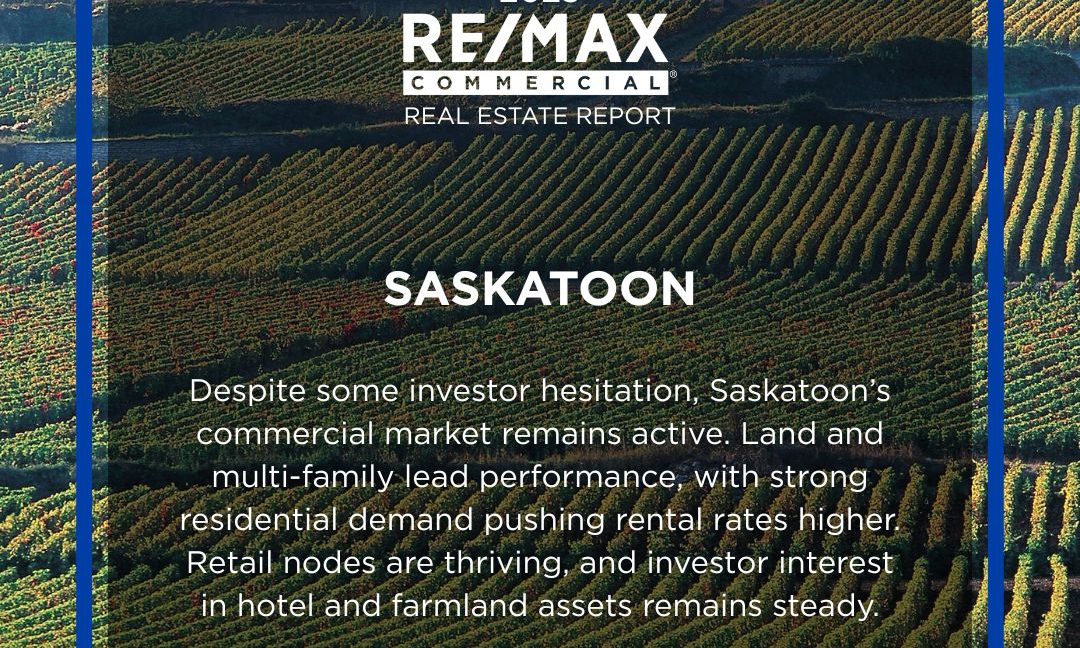While economic uncertainty is causing some hesitancy in the Saskatoon commercial real estate market, year-over-year transactions were up in the first quarter of 2025, with a significant uptick noted in leasing activity. One hundred and seventy-six transactions occurred in the city, an increase of two per cent over the same period in 2024, even as tariffs, reduced immigration levels, and an undervalued Canadian dollar prompted many investors to hit the pause button.
Land and multi-family remain investor favourites
Sales of existing businesses are on the upswing, with liquor, hardware, and other essential retail and industrial experiencing strong demand, particularly with newcomers. Land development remains a popular asset class, with requests for an opinion on land valuations given steep increases in recent years. Most investors are seeking large tracts of land (10 acres plus) within 25 minutes of Saskatoon and zoned either residential or industrial, with prices ranging from $36,000 to $40,000 per acre. While shovel-ready developed land is available for sale, pricing can run as high as $300,000 per acre in Northeast Saskatoon; $180,000 to $300,000 per acre on the city’s Westside; and $120,000 per acres in Dundurn.
Saskatoon’s thriving residential market continues to attract both local and out-of-province investment, particularly from Ontario and British Columbia. Demand continues to outpace supply in the city, hampering home-buying activity, with just 451 properties currently listed for sale. Benchmark prices continue to escalate in response, according to the Saskatchewan Realtors’ Association, rising almost two per cent to $422,600 in April over the previous high of $415,800 set in March 2025. Multiple offers are commonplace, with buyers scrambling to secure accommodations, making the case for greater development.
The multi-family asset class is performing well as a result, with occupancy rates for new apartment and townhouse complexes running at 100 per cent, and cap rates nearing nine per cent. Smaller investors are increasingly active in the market, in large part due to its lower price point. A quick glance at existing listings shows smaller, dated apartment buildings with four-to-six units priced from as low as $1.2 million, while more substantial properties offering 26 – 32 units can be purchased for under $4.2 million. Greater consideration is now being given to these properties in light of substantial increases in rental rates in recent years. According to Rentals.com and Urbanation, the lowest average asking rent for purpose-built and condo rental apartments in April was closing in on $1,500 a month in Saskatoon—up 9.7 per cent over April 2024 levels.
Retail and hotel markets steady
Residential growth continues to drive retail development in Saskatoon. With each new subdivision comes new retail centres anchored by grocery stores, banks, restaurants and other essential businesses. Bustling retail within the city’s neighbourhood nodes including University Heights, Lawson Bridge, Midtown, Broadway, and 33rd St., continue to attract both locals and visitors.
Investor appetite for hotel properties also remains strong, with five selling in recent months. Many of these are smaller hotel/motel-type properties with 80-plus rooms located outside city limits, servicing areas where accommodations are limited. Values typically ranges from $1 million to $5 million, but larger hotel product on the market can climb as high as $15 million. The city has not seen any new hotel development in at least five years. Financing, however, remains a challenge, with most lending institutions looking for as much as 50 per cent down on the proposed rental rate per room.
Vacancy rates in the industrial sector continue to edge upward as new industrial product comes to market. Rates currently hover at three per cent, up significantly over year-ago levels, while absorption levels have softened. While a limited number of owner-occupiers are seeking larger footprint industrial properties over 20,000 square feet, smaller industrial operations at 5,000 sq. ft. tend to sell quickly.
Farmland holds strong despite softer sales
Farmland remains a top performer, although fewer sales have occurred this year compared to last. Statistics from Farm Credit Canada’s 2024 Farmland Values Report released in March 2025, showed Saskatchewan is leading the country yet again in terms of the percentage increase in farmland values in 2024, with price growth in the overall market climbing 13.1 per cent over 2023 levels. This, despite inclement weather that impacted crops throughout the year. Good quality land remains highly sought after, especially in East Central Saskatchewan in markets including Estavan where the price per cultivated acre can reach $3,800 and more. Well-irrigated land continues to draw top dollar, with values increasing year after year. On-going trends include the continued amalgamation of farming operations, while some investors are cashing in their gains considering lower commodity prices. Investor demand for rental land has tapered due to capital gains taxes and growing concerns over tariffs imposed by China, which continues to be the province’s largest customer of Saskatchewan-grown canola and peas.
While downtown office space continues to struggle, there has been some moderate improvement in recent quarters, with the sale of the HSBC and Star Phoenix buildings. Post-pandemic recovery in the city centre is an on-going challenge, which has prompted an exodus of many of the area’s retailers. Suburban A-class office buildings continue to experience healthy demand, with vacancy rates significantly lower than those in the core. Most sales and leasing are occurring in the Stonebridge business centre.
Saskatoon’s commercial real estate market remains resilient amid broader economic headwinds. While factors such as tariffs, financing challenges, and shifting investor sentiment are influencing decision-making, overall activity continues to trend upward, driven by strong fundamentals across land development, residential, and the multi-family sectors. Investor interest in essential retail, industrial space, and farmland underscores a market that remains deeply rooted in necessity-based demand. Meanwhile, the persistent undersupply of housing and rising rental rates are pushing investors toward strategic opportunities. As the city navigates external pressures and local growth dynamics, Saskatoon’s market continues to present attractive prospects.
The post Saskatoon Commercial Real Estate Overview (2025) appeared first on RE/MAX Canada.




